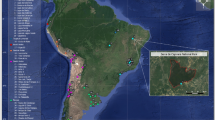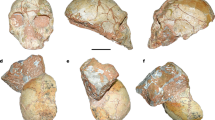Abstract
Jingchuan human fossil, found in Gansu Province in 1976, was given a preliminary report in 1984, but questions remained concerning the age and character of the fossil. We conducted field investigation at Jingchuan in May of 2006 to examine the stratum yielding the human fossil and to obtain sediment samples for optically stimulated luminescence (OSL) dating. Three samples collected from different stratigraphic levels at the fossil locality yielded OSL dates of 15, 48 and 7.9 thousand years ago (ka), respectively. Taking stratum study, mammalian fossils and paleoliths into consideration, the OLS date of 15–48 ka appears to be more close to the true age of Jingchuan cranium. There is no distinct difference between the fossil cranium and modern craniums in terms of the traits analyzed, so the relatively modern traits of the Jingchuan cranium do not contradict with its age. Principal components analysis shows that the Jingchuan cranium may be somewhat primitive.
Similar content being viewed by others
References
Liu Y L, Huang W W, Lin Y P. Human fossil and Paleolithic remains from Jinchuan, Gansu (in Chinese). Acta Anthropol Sin, 1984, 3: 11–18
Xie J Y. Retrospect and progress of Paleolithic archaeology in Gansu. In: Chungbuk National University, Institute of Korean Prehistory, Liaoning Provincial Institute of Archaeology and Cultural Relics, eds (in Chinese). The Paleolithic Culture in Northeast Asia. Shenyang. 1996. 165–177
Zhang H Y. A study on the age and period of the Paleolithic relics in the Upper Reaches of the Jinghe River (in Chinese). J Northwest Univ (Philosophy and Social Sciences Edition), 2005, 35: 87–94
Liu W, He J N, Wu X J, et al. The Comparisons of Cranial nonmetric features between Upper Cave Craniums and modern north Chinese populations, and Late Pleistocene human evolution in China (in Chinese). Acta Anthropol Sin, 2006, 25: 26–41
Liu W, Wu X J, Steve W. Some problems for the Late Pleistocene Human Cranium Found in Liujiang of South China based on morphological analysis (in Chinese). Acta Anthropol Sin, 2006, 25: 177–194
Wu X J. Craniofacial variation in Holocene Chinese population (in Chinese). Doctoral Thesis. Beijing: Graduate School of Chinese Academy of Sciences, 2006. 13–40
Shao X Q. Handbook for Human Body Measurement (in Chinese). Shanghai: Shanghai Dictionary Publishing House, 1985. 1–201
Woo R K. Estimation of age and identification of sex of the fossil human cranium (in Chinese). Vertebr PalAsiatica, 1962, 6: 116–118
Mo S T, Zhang W G, Lei S B, et al. The relation between the age and changes in Chinese cranium suture (in Chinese). Acta Anthropol Sin, 1989, 8: 131–138
Wu X J, Liu W, Wang Z X. A human parietal fossil found at the Shuidonggou site, Ningxia, China. Anthropol Sci, 2004, 112: 83–89
Xie J Y, Zhang Z B, Yang F X. The human fossil of Wushan, Gansu (in Chinese). Prehistory, 1987, 47–51
Wu X J, Liu W, Wu Y S. The pattern of the brain evolution of Chinese fossil Hominids and its implication. In: Dong W, ed. Proceedings of the Tenth Annual Meeting of the Chinese Society of Vertebrate Paleontology (in Chinese). Beijing: Ocean Press, 2006. 109–120
Yunnan Museum. Note on Lijiang Man’s Cranium from Yunnan (in Chinese). Vertebr PalAsiatica, 1977, 15: 157–161
Wu X Z. Study on the Upper man of Zhoukoudian (in Chinese). Vertebr PalAsiatica, 1961, 181-203
Ding S H, Yan X G, Fa D H, et al. The improvement of the measurement and estimation of the cranial capacity (in Chinese). Acta Anthropol Sin, 1992, 11: 241–248
Oliver G, Dricot J M. Estimation of the cranial capacity of fossil hominids. In: Tuttle RH ed. Primate Functional Morphology and Evolution. Paris: Mouton Publishers, 1975. 443–464
Wu X J, Liu W, Christopher Norton. Endocast—the direct evidence and recent advances in the study of human brain evolution. Prog Nat Sci, 2007, 17: 705–715
Wu X J. Morphological variation of middle meningeal artery and its significance in human evolution (in Chinese). Acta Anthropol Sin, 2003, 22: 19–28
Li H J, Wu X J. Sex Determination of the human fossil cranium from Jingchuan (in Chinese). Acta Anthropol Sin, 2007, 26: 107–115
Wu X Z. On the racial types of the Upper Cave Man of Choukoutien (in Chinese). Sci Sin, 1961, 10: 999–1005
Coon C S. The origin of the races. New York, Alfred A. Knopf, 1962
Suzuki H. Craniums of the Minatogawa Man. In: Suzuki H, Hanihara K, eds. The Minatogawa Man. Tokyo: The University of Tokyo Press, 1982. 7–49
Pei W Z, Woo R K. Ziyang Man. Beijing: Science Press, 1957. 1–71
Woo R K. Human fossils found in Liukiang, Kwangsi, China (in Chinese). Vertebr PalAsiatica, 1959, 1: 97–104
Wu M L. Late Homo sapiens in China. In: Wu R K, Wu X Z, Zhang S S, eds. Early Humankind in China (in Chinese). Beijing: Science Press, 1989. 42–61
Frayer D W. Biological and cultural change in the European from Late Pleistocene and Early Holocene. In: Smith F H, Spencer F, eds. The Original of Modern Humans. New York, 1984. 211–250
Lahr M, Foley R. Towards a theory of modern human origins: Geography, demography, and diversity in recent human evolution. Yearbook Phys Anthropol, 1998, 41: 137–176
Jantz R, Owsley D. Variation among early north American crania. Am J Phys Anthropol, 2001, 114: 146–155
Zhang Z B. Evidence for origin of Chinese populations: Time and space changes of craniometric traits (in Chinese). Quat Sci, 1999, 2: 113–124
Zhang Z B. On the geographical distribution of the physical feature of the Neolithic population in China (in Chinese). Vertebr PalAsiatica, 1981, 19: 87–97
Liu W, Wu X J, Steve W. Some problems for the Late Pleistocene human cranium found in Liujiang of south China based on morphological analysis (in Chinese). Acta Anthropol Sin, 2006, 25: 177–194
Author information
Authors and Affiliations
Corresponding author
About this article
Cite this article
Li, H., Wu, X., Li, S. et al. Late Pleistocene human skull from Jingchuan, Gansu Province. Chin. Sci. Bull. 55, 1047–1052 (2010). https://doi.org/10.1007/s11434-009-0462-2
Received:
Accepted:
Published:
Issue Date:
DOI: https://doi.org/10.1007/s11434-009-0462-2




